About
16 November 2022
Magician of Light
How a scientist from Tokyo became one of the most prolific hologram artists in the world.
日本語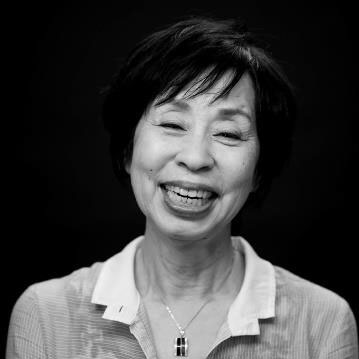
Setsuko Ishii
SamBarkerPhotography (2021)
When a young Setsuko Ishii was walking through the streets of Tokyo in 1974, a spectacular sight caught her eye. “When I moved, I saw an image in mid-air shift its position, but I could not grasp it even though it was in the palm of my hand. I was completely mesmerized by this unprecedented visual experience. This was my first encounter with a hologram.” For the young scientist who practiced painting in her spare time, this experience had a profound effect. For centuries, many great artists have tried to capture the visual effects of light while scientists have worked to understand its technical properties. Few have attempted to bridge both worlds and harness light from artistic and scientific viewpoints, but Ishii would. She studied the science of light and captured its magic to create an iconic art style. “Holography is a medium that ‘spins out’ light. Everyone has likely seen such breath-taking moments as a rainbow that appears after the rain, a burning-red sunset, or the deep blue at twilight that envelops and submerges all things. In such moments, we are reminded of the existence of sunlight and become conscious of nature itself.”
Ishii began her applied physics studies in 1970 as an undergraduate at the Tokyo Institute of Technology (TIT). She loved physics, but something always pulled her away from the subject: she also loved art and painted in her spare time. “I wondered, ‘maybe I’m not a scientist? Perhaps I am a painter?’" She considered quitting physics, but her family urged her to finish her degree. "I had no idea there was a field between art and science."
"I wondered, 'maybe I'm not a scientist? Perhaps I am a painter?'"
After graduating from TIT, Ishii made a bold move for a physics graduate and joined the Sokei Academy of Fine Arts in Tokyo, where she began her second career as an artist studying fine art and European oil painting. "It was wonderful. I studied classical art and oil painting. I saw genius painters make beautiful artwork." She then studied Fine Arts and painting at L’École National Superieur des Beaux-Arts for another year. “It was heaven!” Ishii began to exhibit her paintings. "I had a solo exhibition when I finished art school. I had learned many contemporary art styles, but I could not find a suitable direction. Despite having solo and group exhibitions, I asked myself: ‘is painting a suitable medium for me?’”
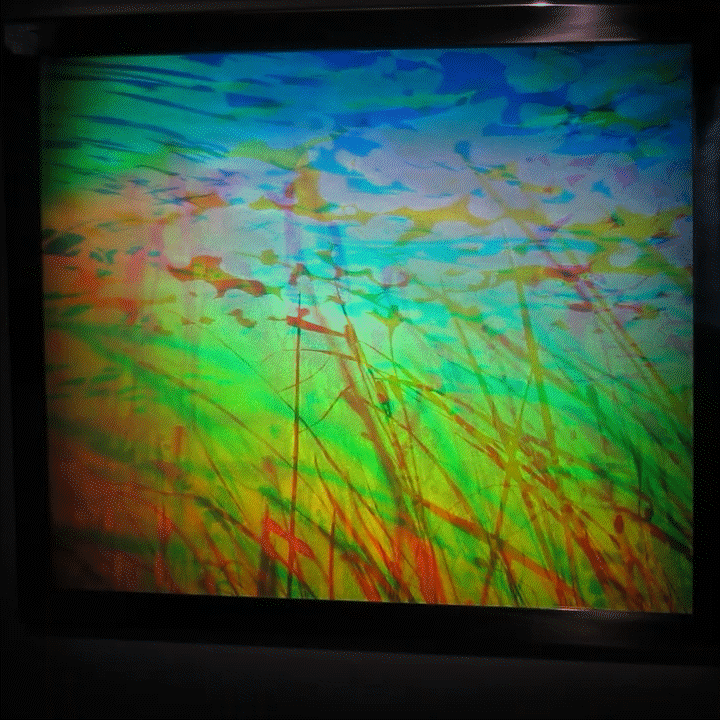
Setsuko Ishii – "Fragment of Nature" Silver-halide transmission hologram on mirror (2016).
As she did while studying physics, Ishii always had one eye on her other passion: when she studied and practiced art, she was now thinking about science. The encounter with a hologram on a Tokyo street would show her how to combine both fields that she loved. “When I saw it for the first time, I was shocked. I had never seen a virtual, 3D image that existed in the air where I couldn’t catch it. I wanted to know more about this medium. It was a kind of three-dimensional photography where you could make pictures not with a camera lens but from light waves. It was both art and science – perfect for me. It was an unknown realm that I sought, rapidly expanding deep and wide.”
Holography was invented in 1947 by Dennis Gabor, a Hungarian engineer working on improving electron microscopes. Although electron microscopes could resolve structures 100 times smaller than light microscopes, they were limited by hard-to-make electron optical elements. Gabor proposed eliminating the electron optics and instead making an electron hologram that could be processed later using light. Gabor coined the term by combining the Greek words holos (or “whole”) and gram (“message”) as it contained all the information from the wave lighting the object. Shortly after that, he made a hologram with light. Holography as we know it now, with clear, vivid 3-D images, was developed in 1962 by Michigan professor Emmett Leith and then-student Juris Upatnieks. In 1971, Gabor was recognized with the Nobel Prize for Physics for inventing holography.
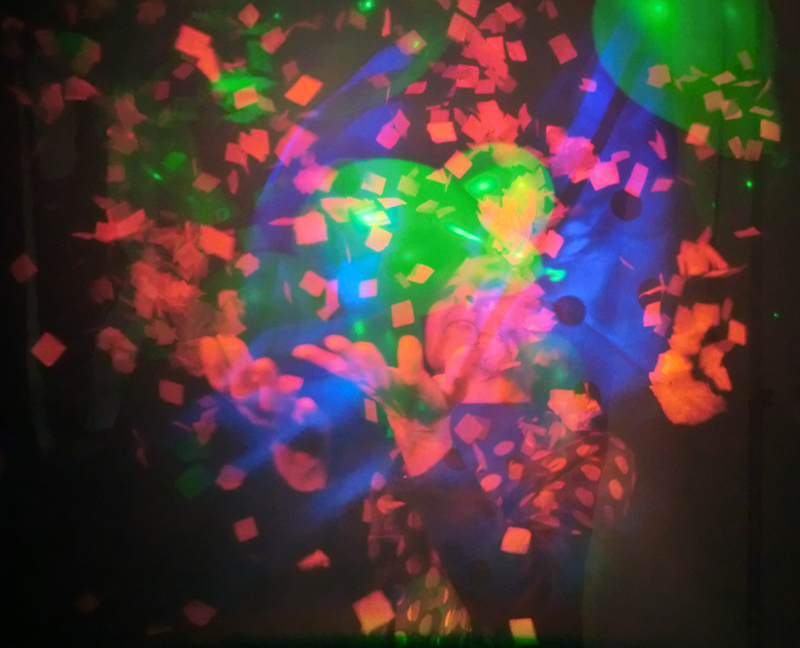
Setsuko Ishii – "Self Portrait" Multicolor, multichannel hologram (2013)
The scientist in Ishii wanted to learn everything there was to know about holography. When she returned to Tokyo in 1978, she sought Optica Fellow, C.E.K Mees Medalist and Emmett N. Leith Medalist Professor Jumpei Tsujiuchi, a leading expert on holography at the time and explained her newfound interest. "Professor Tsujiuchi told me he would not accept me as an art student. He explained that if he accepted me this way, it would create a precedent, and lots of art students would start applying. But he could see my passion and made an exception for me, so I got accepted as a TIT science graduate.” She re-enrolled at her alma mater and became an image science and engineering research student. “For a few years, this continued. I studied holography and made experimental holograms. I almost forgot I wanted to be an artist!”
"I studied holography and made experimental holograms. I almost forgot I wanted to be an artist!"
Before Ishii created her first art with holography, it was already catching on as a creative medium with artists in other parts of the world. In 1967, Margaret Benyon, an artist from Birmingham, UK, was experimenting with techniques involving optical illusions and came across a newspaper article on holography. As a fellow in fine art at the University of Nottingham, she had access to the mechanical engineering department and made her first laser holograms with the university's optical equipment. It did not take Benyon long to hold her first exhibition. In 1969 she showed a collection of holographic artwork at the University of Nottingham art gallery. In the USA, conceptual artist Bruce Nauman produced pulse laser portrait holograms of his own face making exaggerated expressions. With Making Faces, Nauman presented his first holography exhibition in 1968. A decade later, Ishii would take this new art form to another level by staging the largest outdoor holographic exhibitions in the world.
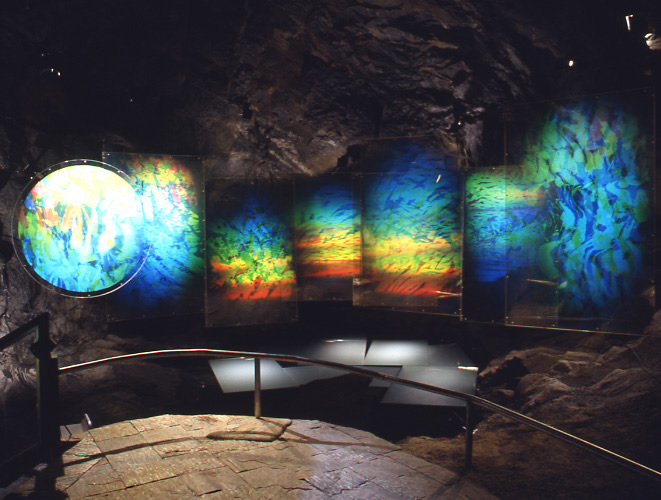
Setsuko Ishii – "Aquarius Whisper" Multicolor rainbow hologram (1994)
When Ishii became enamored with sunlight, her interest turned to the outdoors. “My focus turned from the objects themselves to the environmental space. I began to think about the entire space in a gallery, about environments, and then about taking my artwork outside. It evolved into an outdoor installation.” Displaying her work outdoors in natural light was as much a scientific decision as it was an aesthetic choice. “Light is essential to reproduce holographic images. Vivid colors that appear in the image become visible via reproducing the light source, broken down into various wavelengths. This light source can involve a variety of conditions, but I learned that sunlight is perhaps one of the most ideal light sources. This inspired my awareness of sunlight, which I had taken for granted until then. I became aware that the light of the sun, which had been an unconscious element to me as much as the air that we breathe, was the most familiar natural element to us and to all forms of life on this earth, as well as an indispensable and irreplaceable one."
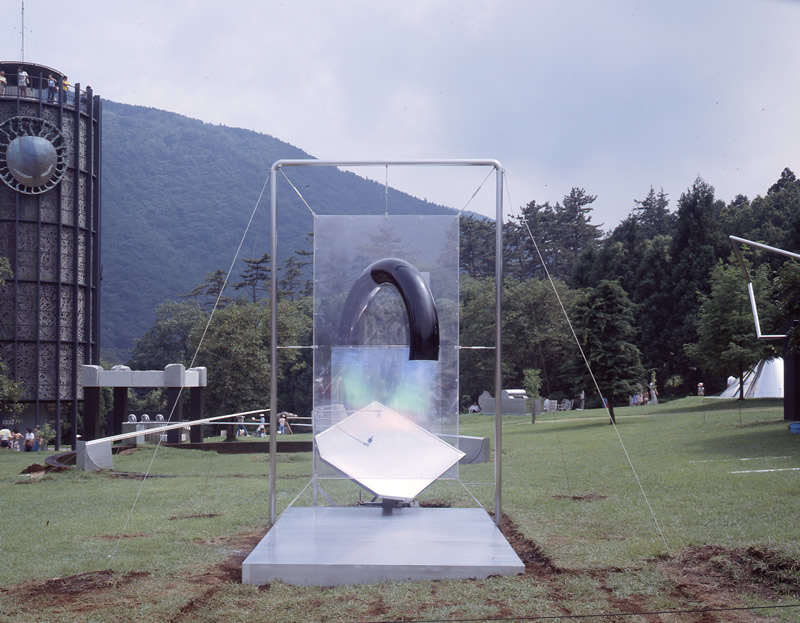
Setsuko Ishii – "Encounter II" First outdoor sculpture Henry Moore grand prize Exhibition, a competition at Hakone Open – Air Museum.
In 1979 Ishii submitted her large-scale sculpture and first outdoor artwork at the first Henry Moore Grand Prize Exhibition, a competition at the Hakone Open-Air Museum Japan. "As I had been used to exhibiting my paintings in exhibitions, this was the natural next step.” Titled “Encounter II,” her display consisted of a rainbow hologram and sunlight. “Half of the ring was a real object, and the other half was a reconstructed hologram image. I was interested in the contrast between the real and the unreal in this work. The hologram was illuminated by sunlight reflected from the mirror, which automatically tracked the sun. The size of the rainbow hologram was 80 cm × 100 cm, which was one of the largest in the world at that time."
Viewers did not know how to react to this innovative idea or the medium. "Contemporary artists were creating interesting and funny artwork. But people who visited my works did not understand what they saw. They didn't complain, which I took as a good sign. But all the time, all anyone wanted to know was, ‘what is the technique? What is this?’ They didn’t mention the idea behind the art or question it. Only, ‘what is this I’m looking at?’ Finally, I answered. 'You watch TV, but do you know how the images are created? It's just a black box, but you enjoy watching the TV. You don't need to know how my art works, so enjoy it!’"
"It was an unknown realm that I sought, rapidly expanding deep and wide."
Today, Ishii is celebrated as one of the most prolific holographic artists in the world. Called the “Magician of Light” by the Japan Times, her exhibitions and public installations have been shown all around the world, from Palazzo Fortuny in Venice, Italy, to the Walker Hill Art Center inSeoul, South Korea. She has been named artist in residence at the Museum of Holography in New York three times and artist in residence in Paris. She has received numerous prizes for her work, including a Massachusetts Institute of Technology (MIT) fellowship for advanced visual studies.
Ishii’s scientific background and dual passion for art and optical science had created a whole new artistic experience. “By using the colors of light as paints, and a three-dimensional space itself as a canvas, I generated a spatial environment that embraced the viewers. This method allowed me to ‘mold’ light like clay in the palm of my hands. Thus, without the need to wait for the rain to let up, I could produce a rainbow by freely playing with the sun. And in the completed space of the work, it was possible for the viewers to encounter a burning sunset or the deep blue at twilight.”
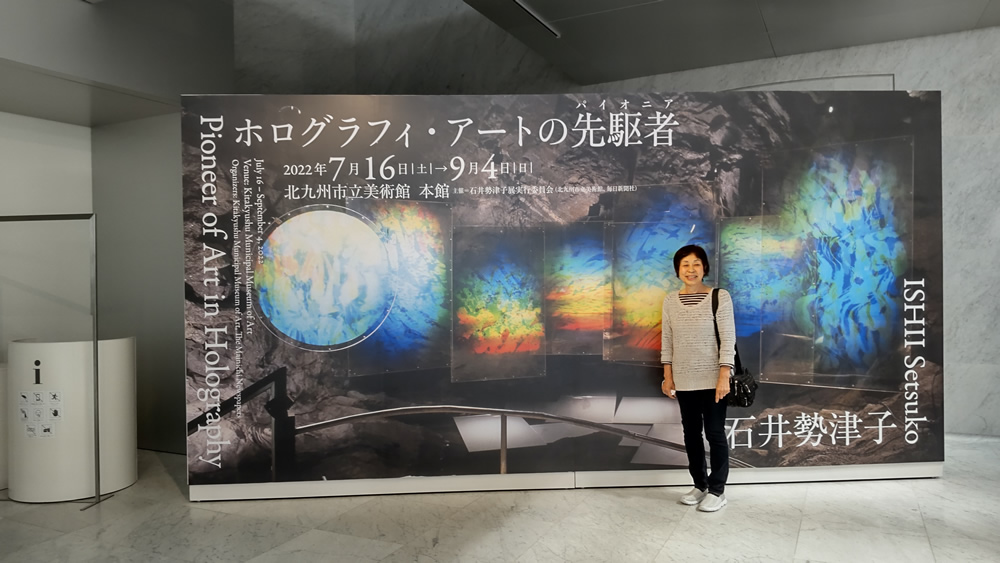
Setsuko Ishii at a solo show at the Kitakyushu Municipal Museum of Art. July 2022.
The Optica Community unites a diverse, global population of students, scientists, engineers and professionals. We invite everyone in our community to forge the connections vital to solving societal challenges through light science and technology.
English
16 11月 2022
光の魔術師
一人の東京の科学者が、いかにして世界で最も多くのホログラムを制作するアーティストとなったか。

石井勢津子
SamBarkerPhotography (2021年)
1974年のある日、東京の街を歩いていた石井勢津子は不思議な光景に目を奪われた。「空中に浮かんだ映像が、視点を変えると動き、手のひらに乗っているのにつかめない。今までにない視覚体験に、すっかり魅了されました。これがホログラムとの最初の出会いでした」。余暇に絵画の練習をしていた若い科学者は、この体験から大きく影響を受けることになる。何世紀にもわたって、多くの偉大な芸術家達が光の現象を捉えようとする一方、科学者達はその技術的特性を理解しようと努力してきた。この二つの視点を結び付けて光を操ろうとする者は少なかったが、石井はそれを実現した。彼女は光の科学を研究し、その魅力を捉えて、独創的なアートスタイルを作り上げたのだ。 「ホログラフィーは、光を 『紡ぎ出す』メディアです。雨上がりの虹、真っ赤に燃える夕焼け、すべてを包み隠すような黄昏時の深い青など、誰もが一度は目にしたことがあるでしょう。その瞬間に、私たちは太陽の存在を思い出し、自然そのものを意識するようになるのです」。
石井は、1970年に東京工業大学の学部生として応用物理を学び始めた。物理は好きだったが、美術も好きで、余暇には絵をかいていた彼女は、いつも何か心に引っかかるものを感じていた。「私は科学者ではないのだろうか?もしかしたら、私は画家なのかもしれない 。」と思い始めた彼女は、物理学の研究をやめることも考えたが、学位の取得を家族に促された。「芸術と科学の間の分野が存在するなんて想像もつきませんでした。」
東京工業大学を卒業後、石井は物理学科出身者としては大胆な行動に出て、東京の創形美術学校に入学し、美術やヨーロッパの油絵を学ぶアーティストとしてのセカンドキャリアをスタートさせた。「すばらしかったです。古典美術と油絵を学びました。天才画家達が美しい作品を作るのを見ました」。その後、パリ国立高等美術学校でさらに1年間、美術と絵画を学ぶ。「天国でした!」。 石井は、展覧会に絵を出品するようになった。「美術学校を卒業するときに個展を開きました。現代美術の様式をいろいろと学びましたが、方向性が定まりませんでした。個展やグループ展を開催していたにもかかわらず、『絵画は本当に自分に適したメディアなのか』と自問自答していました」。

石井勢津子 – 「Fragment of Nature」 鏡面銀塩透過型ホログラム (2016年).
物理学を学んでいた時もそうだったが、石井は常にもう一つの分野に心惹かれていた。美術を学び、実践する今は、また科学のことを考えていた。 東京の街角で出会ったホログラムが、彼女が大好きな両分野をどう結びつけるかを示してくれたのだ。「初めて見たとき、私は衝撃を受けました。空中に浮かび、手でつかめない3Dの虚像は見たことがありませんでした。このメディアについてもっと知りたいと思いました。カメラのレンズではなく、光の波動で絵を描く立体写真のようなものでした。アートでもあり、科学でもあり、私にはまさにぴったりのもので、この未知の領域を、深く広く追及して行きました」。
ホログラフィーは、1947年、電子顕微鏡の改良に取り組んでいたハンガリーの技術者デーネシュ・ガボールによって発明された。電子顕微鏡は、光学顕微鏡の100分の1の大きさの構造を見ることができたが、電子光学素子の製作が難しいという制約があった。ガボールは、この電子光学素子を取り除き、後で光で加工できる電子ホログラムの作成を提案した。ガボールが名付けた「ホログラム」は、ギリシャ語の「ホロス(全体)」と「グラム(メッセージ)」を組み合わせた造語で、対象物を照らす波の情報がすべて含まれていることを意味する。その後、彼は光でホログラムを作った。現在知られている鮮明な3D画像のホログラフィーは1962年、ミシガン大学のエメット・リース教授と当時学生だったジュリス・ウパトニークスによって、が開発された。1971年、ガボールはホログラフィーの発明でノーベル物理学賞を受賞した。

石井勢津子 – 「 Self Portrait 」 マルチカラー、マルチチャンネルホログラム (2013年)
科学者でもある石井は、ホログラフィーのすべてを知りたいと思った。1978年、東京に戻った彼女は、当時ホログラフィーの第一人者だった、オプティカ・フェロー、C.E.K Meesメダリスト、Emmett N. Leithメダリストの辻内順平教授を訪ね、自分の新しい興味を説明した。「辻内先生には、『美大生としては受け入れられない』と言われました。そうしてしまうと前例ができて、美大生がたくさん志願するようになってしまうからだとのことでした。でも、私の情熱を見て、例外的に東京工業大学の卒業生として受け入れてくれたのです」。石井は母校に再入学し、像情報工学研究施設で研究生となった。「数年間は、ホログラフィーの勉強をしたり、実験的なホログラムを作ったりという状態が続き、アーティストになりたいと気持ちを忘れるところでした。」
石井がホログラフィーを使った作品を制作する以前から、ホログラフィーは世界のアーティストたちの間で創作メディアとして注目されていた。1967年、英国バーミンガム出身のアーティスト、マーガレット・ベニヨンは、目の錯覚を利用した技法を試していたところ、ホログラフィーに関する新聞記事を目にした。ノッティンガム大学で美術を専攻していた彼女は、機械工学科を利用し、大学の光学機器を使って最初のレーザーホログラムを作り、最初の展覧会を時を待たず開催した。1969年にノッティンガム大学のアートギャラリーでホログラフィーの作品集を展示したのだ。アメリカでは、コンセプチュアル・アーティストのブルース・ナウマンが、誇張された自画像のパルスレーザー・ポートレート・ホログラムを制作し、1968年には「Making Faces」で、ナウマンは初のホログラフィーの展覧会を開催した。その10年後、石井は世界最大規模の野外ホログラフィック展を開催し、この新しいアートの形をさらに進化させることになる。

石井勢津子 – 「 Aquarius Whisper 」 マルチカラーレインボーホログラム (1994年)
石井が太陽光に魅了された時、その興味は屋外に向いた。「私の関心は、モノそのものから環境空間へと向きました。ギャラリーの空間全体や、環境について考えるようになり、さらに作品を屋外に持ち出すことにしました。それが、屋外でのインスタレーションへと発展していったのです」。自然光の入る屋外で作品を展示することは、美的な理由があると同時に科学的な理由もあった。「ホログラフィックイメージを再現するためには、光が必要不可欠です。光源を様々な波長に分解して再現することで、映像に現れる鮮やかな色が見えるようになるのです。この光源にはさまざまな条件がありますが、太陽光は最も理想的な光源の一つであることを知りました。それまで当たり前だと思っていた太陽光を意識するようになりました。私たちが呼吸する空気と同じように、私にとって無意識の要素であった太陽の光は、私たちやこの地球上のあらゆる生命体にとって最も身近な自然の要素であり、欠くことのできないかけがえのないものであることに気づかされました」。

石井勢津子 – 「 Encounter II 」 箱根彫刻の森美術館で開催された第1回ヘンリームーア大賞展での初の屋外作品
1979年、石井は箱根彫刻の森美術館で開催された第1回ヘンリームーア大賞展に、大型彫刻と初の屋外作品を出品した。「絵画を展覧会で発表することには慣れていたので、自然な流れでした」。「Encounter II」と題された彼女の作品は、虹色のホログラムと太陽光で構成されていた。「リングの半分は実物で、もう半分はホログラムで再構成された映像でした。この作品では、現実と非現実のコントラストに焦点を当てました。ホログラムは、太陽を自動追尾する鏡に反射した太陽光で照らされていたのです。虹のホログラムの大きさは80cm×100cmで、当時としては世界最大級でした」。
この斬新なアイデアやメディアに対して、見る人はどう反応していいのか分からなかった。「現代美術家たちは、面白くて笑える作品を作っていました。しかし、私の作品を訪れた人たちは、何を見たのか理解できませんでした。文句を言われないのはいい兆候だと思いました。でも、みんなが知りたがるのは、『この技法は何?これは何?』でした。彼らは芸術の背景にある考えには言及せず、疑問も持たなかったのです。ただ、『私が見ているのは何なのか?』を知りたかっただけでした。最終的に私は言いました。『テレビを見ているとき、どのように映像が作られているか理解していますか?ただの黒い箱だけど、テレビを見ていると楽しいでしょう。私の絵の仕組みは知らなくていいので、楽しんでください。』って」。
現在、石井は世界で最も多くの作品を発表しているホログラフィック・アーティストの一人として知られている。ジャパンタイムズ紙で「光の魔術師」と呼ばれ、イタリア・ベネチアのパラッツォ・フォルチュニから韓国・ソウルのウォーカーヒルアートセンターまで、世界中で彼女の展覧会や公開インスタレーションが展示されてきた。ニューヨークのホログラフィー美術館のアーティスト・イン・レジデンスに3度任命され、パリのアーティスト・イン・レジデンスに任命されている。また、マサチューセッツ工科大学(MIT)の高等視覚研究フェローシップなど、数々の賞を受賞している。
石井の科学的なバックグラウンドと、アートと光学科学の2つの分野に対する情熱は、全く新しい芸術体験を生み出した。「光の色を絵の具として使い、3次元の空間そのものをキャンバスにすることで、見る人を包み込むような空間環境を作り出しました。これによって、手のひらの上で粘土を練るように、光を操ることができるようになったのです。なので、雨が上がるのを待つことなく、自由に太陽と戯れながら虹を作り出すことができます。そして、完成した作品の空間の中で、燃えるような夕焼けや黄昏時の深い青に出会うことができたのです」 。

北九州市立美術館で開催された個展での石井勢津子。2022年7月。
Optica コミュニティは、学生、科学者、エンジニア、専門家など、多様でグローバルな人々を結びつけています。私たちは、このコミュニティで、光の科学技術を通じて社会の課題を解決するために不可欠なつながりを構築するよう、みなさんに呼びかけています。
Media Contact
